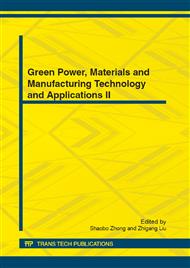p.486
p.491
p.495
p.500
p.505
p.510
p.515
p.520
p.527
Research on the Green Building Revolution - Solar Energy Research and Development in Taiwan
Abstract:
Taiwan is located in the West Pacific Earthquake Zone. Fulda Nuclear power plant disaster caused by March 11, 2011 earthquake not only impact Japan, all countries around this area have been forced to face the radiation threaten. This event strengthens advanced organizations to search the green energy. Solar energy and wind power that utilizes the nature to generate electricity energy are widely accepted around the world. In April, 2011, Germany has passed the waste nuclear provision. The BIPV (the Building Integrated Photo Voltaic) has not only the economic benefits of energy generation also reduce the carbon emissions and building initial cost. The Renewable Energy Sources Regulations has been established in June 12, 2010 in Taiwan that proclaimed the green energy generation has been started. The development of Photovoltaic was discussed in this study. The Government's efforts to construct the wind power energy were analyzed to explore the research potential of green energy development in Taiwan. The development goals and vision were explored for Taiwan's energy resource in this article. The power conversion efficiency of commonly used solar cells was investigated. Through the investment in key bottleneck and innovative technologies, the government provides incentives to increase domestic demand and consumption. Focusing on the international market to enhance the scale can construct a perfect green value chain in Taiwan.
Info:
Periodical:
Pages:
505-509
Citation:
Online since:
November 2012
Authors:
Price:
Сopyright:
© 2012 Trans Tech Publications Ltd. All Rights Reserved
Share:
Citation:



